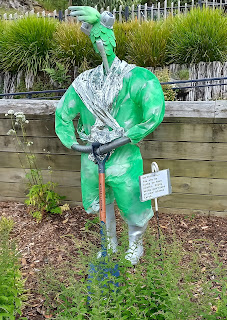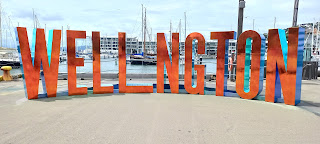 |
| The view from the Victoria lookout onto Wellington |
I arrived in Wellington to more torrential rain. A pair of wellingtons would have come in handy as I waded to my hotel (turns out it was a hostel as well, complete with full kitchen, which I failed to find until the day I left).
 |
| Including this guy skinny-dipping |
Also in the harbour area was "the last working self-propelled floating steam crane in New Zealand", which was built in Paisley and shipped down under in 1926.
 |
| Nearly as good as the Finnieston Cran |
I realised that one thing I hadn't done on this tour was visit a national parliament. Happily, within 30 seconds of searching whether that was possible, I was signed up to a tour the next day. Although the main chamber is located in a much older building, most of the work takes place in the Beehive, which was built in the 1970s and designed by the architect Sir Basil Spence - who also designed several of the high-rise flats in Glasgow.
 |
| The Beehive (on the left) |
The tour was excellent (and free!), and as a bonus, was led by a friend of mine in Scotland's mother's cousin (who like half of Kiwis, emigrated from the UK). Sadly, no phones/cameras were allowed on the tour, but I did get a picture of this poster - presumably dating from 1893 when New Zealand became the first country to grant women the vote - railing against "epicene women ... unsexing themselves ... about matters which they are profoundly ignorant."
Just a short cable car journey / long walk uphill from the parliament was Wellington's botanic gardens, which was massive (25 hectares, and as you'd expect, filled with hundreds of different trees and plants, as well as statues by famous artists, and an observatory. Oh, and this alien.
 |
| "Earthlings ... You are so lucky to have plants. Enjoy being guardians of your planet Earth." |
I tried and failed to find out how many gardeners it takes to maintain the gardens, but I can imagine it's a fair few.
 |
| The view from the top of the cable car |








Comments